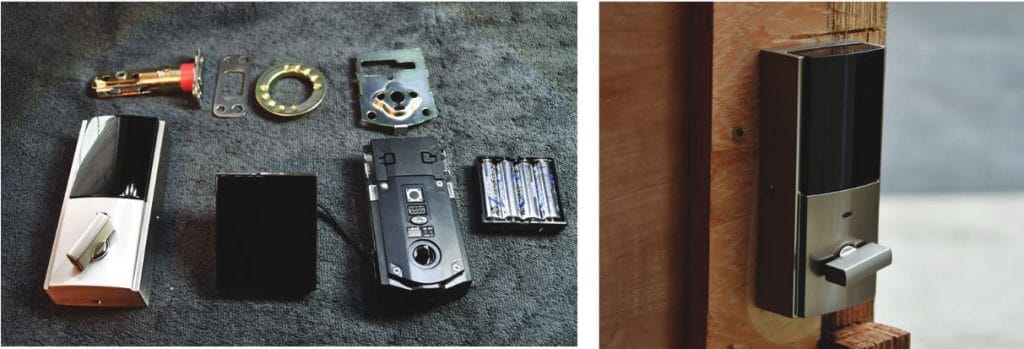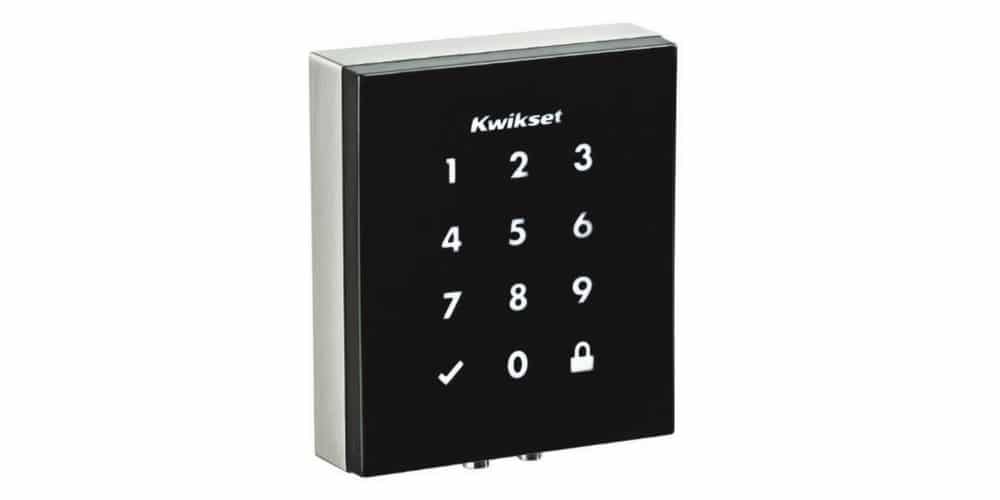The Kwikset Obsidian is a motorized deadbolt lock with a touchscreen keypad for control and utilizes Z-Wave Plus.
We have reviewed a number of electronic locks, including units with touchscreens (deadbolt and lever handle models), push-button locks of both types, and even a deadbolt-only smart lock with no means of exterior access (other than the key, of course).
Completing the picture is the Kwikset Obsidian Electronic Touchscreen Deadbolt (Obsidian), which lacks a cylinder (keyhole), presenting just a small (approximately 21⁄2-inch X 3-inch) rectangle that turns into an illuminated touchscreen when activated.
Kwikset Obsidian Touchscreen Electronic Deadbolt
Specs
- Touchscreen and Z-Wave controlled motorized deadbolt lock
- Residential to light commercial single colored doors
Pros
- Sleek appearance
- Covert - it does not look like a lock
- Solid construction
- Z-Wave technology integrates with home automation systems
Cons
- Some difficulty in aligning both sides during installation
Construction
The Obsidian is a motorized deadbolt lock with a touchscreen keypad for control. More than just a fancier design, there are some practical advantages for touchscreens over pushbutton locks — mainly the numbers don’t show dirt or wear, a quick and easy way to thwart such systems.
In the timeframe in which the numbers have begun to wear off a pushbutton lock from another manufacturer, the touchscreen design on our Kwikset 916 (reviewed in June 2016) still looks new. The Obsidian is only a keypad; if you are looking for a unit with a keyway as well, the 916 remains an excellent alternative.
The Obsidian fits standard thickness doors (13⁄8 inches to 2 inches) with no screw holes needed and is available in two finishes including Venetian Bronze (dark) and the one we tested, Satin Nickel. The exterior trim color is only visible on a slim side wrap around the keypad but is prominent on the inner housing, so choose accordingly.
Personally, I’d match the interior and not worry about the exterior. The deadbolts will fit either a 11⁄2-inch or 21⁄8-inch cutout and come with an adaptor ring for use in the latter. Either a 23⁄8-inch or 23⁄4-inch backset is acceptable, and the kit includes an adjustable deadbolt, with an optional drive-in deadbolt available.
No keyway means the lock cannot be picked or bumped, adding to the security advantage. However, no key also means that there’s no backup method of opening the door. Fortunately, artfully blended battery terminals let you press a 9V battery against the underside of the panel, powering the lock temporarily to gain access.
It is recommended that you replace the batteries immediately after using this emergency method, but we tried it multiple times with no issues for both locking and unlocking.We had a few issues on the construction side that concerned us, however.
First, there are four screws holding the interior mechanism face-plate to the rest of the lock; when our test unit arrived, one of the screws was missing (we found it loose in the box) and when we put it back in, it did not really tighten; it screwed in but never stopped spinning.
A second screw did not fall out but was loose as well; the other two were fine. This is likely a quality control issue and we provided feedback to Kwikset. Second, the nature of this locking mechanism makes it somewhat difficult to align.
There are really only two screws holding the back and front halves together, unlike cylinder models that include more center mass. It took us three tries, taking the back off and putting it back on again, to get them aligned properly so the unit would lock and unlock without an error code.
The error code was great; we knew exactly what had to be done to fix the problem, but fixing it took a little time. It should be noted that, even with the front and back halves misaligned, the lock worked perfectly, except for the beeping and flashing lights.
Kwikset Obsidian Features
There are two versions of the Obsidian, a nonconnected version and a Home Connect version. The Home Connect version allows more user codes to be programmed (30 versus 16 for the nonconnected version) and remote programming and operation through a home automation system.
It features the latest Z-Wave protocol and certification, called “Z-Wave Plus,” which allows for extended wireless range with wireless encryption, and over-the-air firmware updates.
While we tested the Z-Wave version of the Obsidian with a SmartThings hub and a Qolsys IQ Panel 2, the IQ Panel 2 had tighter integration and is the more likely configuration to be used by a security professional.
The touchscreen is standout in terms of performance and sensitivity. When you press a couple of fingers against it (or your palm), it lights up and is readable even in the brightest direct sunlight.
It features Kwikset’s SecureScreen, which first presents two random numbers to the user. Once these are pressed, the full screen appears, and you enter your user code. The increased usage of the touchscreen surface masks the correct numbers that are employed for user codes and prevents passcodes from inadvertently being jeopardized by guessing the combination based on smudges or oily residues on the touchscreen surface.
When locking and unlocking with the touchscreen, the lock is operated by a motor that mechanically turns the actuator and the interior thumb-turn in the handle.
Locking from the inside is done by simply turning the handle; the lock keeps track of its mode whether actuated manually or via the motor, and reports back to the linked system, via Z-Wave.
In the case of the Qolsys system, information as to battery life remaining was reported in addition to the lock state. The lock may also be set (by means of a DIP switch) to automatically relock the door 30 seconds after unlocking, and the audio tones confirming keyboard entry may be disabled.

The lock is simple to install, as with other Kwikset models we have tested, and everything outside of door prep can be done with a single #2 Phillips screwdriver. Our test unit was installed on a shed door (right) and the tapered deadbolt design helped align the doors when locking.
Setup
Keeping with tradition, the “Installation and User Guide” that comes with the Obsidian is big on graphics and easy to understand. The battery pack is thoughtfully labeled so it cannot be installed in the wrong direction or orientation, and there are various visual and audible warnings when the battery runs low.
Connectors are keyed with a stamped white marking to ease in orientation, and programming instructions for adding the initial user code are provided inside the battery cover on a handy (and easy-to-understand) sticker.
Connectivity is limited to Z-Wave through a hub or panel; you are limited to manual programming through the touchscreen. Setup of advanced features relies on third-party support; your mileage may vary. When pairing the lock to our Qolsys panel, “Advanced Z-Wave” had to be selected from a configuration menu for pairing to succeed.
Once paired, user codes were sent to the lock automatically once users were given the appropriate permission through Alarm.com. The touchscreen programming instructions for the lock are easy to understand, but not having to enter codes or delete them later made the whole process easier. Pairing to a home automation hub is equally as simple, with a phone app (provided by the hub manufacturer) and a single button press.
Testing
We installed the lock on a shed door, and while that may not be a typical application, it makes a lot of sense. The black rectangle on the shed door does not look like a deadbolt so it does not shout “valuables inside” to passersby.
The touchscreen can be used to unlock the shed when you need access, but once unlocked you can leave it that way, knowing that the shed will be automatically locked whenever you leave, and the alarm system is armed. I set ours to lock at night too, and when my phone left for an extended period.
We had a Schlage deadbolt on the shed door that used a keypad but had to be manually locked (press a button and turn a knob). There were times when the shed doors were not aligned properly, and you’d have to move them around to get the bolt to fully engage.
Not so with the Obsidian, or other motorized Kwikset locks. The tapered deadbolt visibly pulled the door into alignment each time, making it an unattended process.
Here again, the Qolsys panel and Alarm.com enhanced the usability of the lock. The panel shows if the lock is locked or unlocked, as well as battery capacity remaining. When the lock jammed there was a panel notification, and when I removed the battery pack to test the front panel battery terminals I got an email, an alert on my phone and notification on the panel.
Another nice feature is the indicator light on the interior side of the lock. This status LED indicates whether the lock is locked, unlocked, has a low battery and/or was not programmed correctly. For example, a blinking green indicated an unlocked condition, blinking amber — locked and blinking amber/red is locked/low battery.
Conclusions
We’ve reviewed several Kwikset locks and have never been disappointed. While we had a few issues with construction, that does not take away from the fact that this is an excellent product. It provides aesthetic options that can round out an integrator’s product offering, while helping keep contents and people safe inside.
Verdict
- Features 1 2 3 4 5
- Construction 1 2 3 4 5
- Setup 1 2 3 4 5
- Performance 1 2 3 4 5
- Overall 1 2 3 4 5






